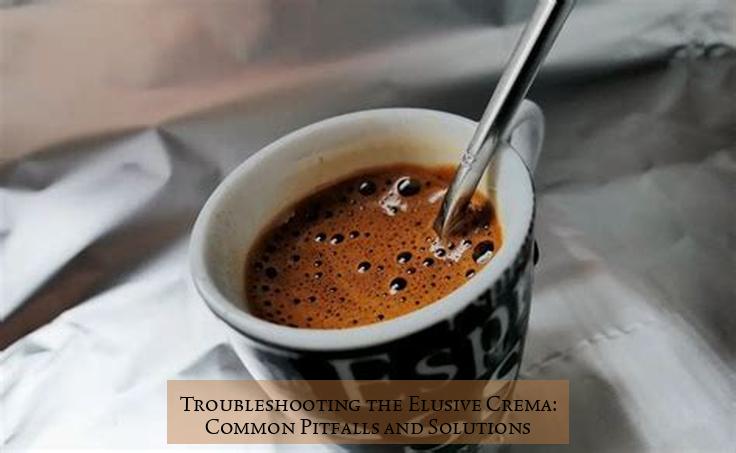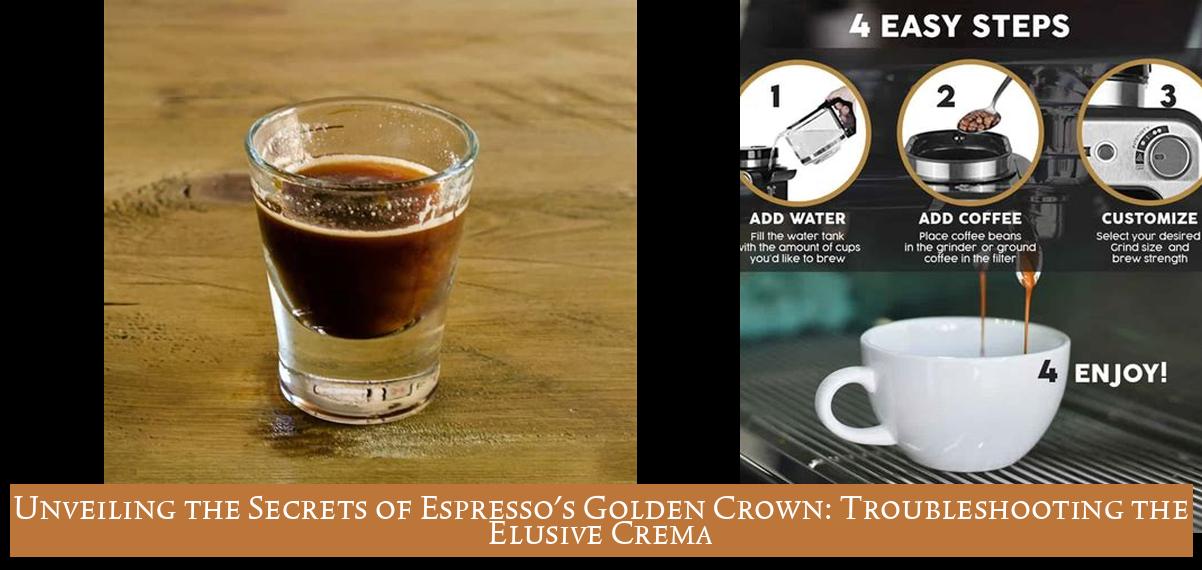Unveiling the Secrets of Espresso’s Golden Crown: Why is there no crema on my espresso? Picture this: you eagerly prepare your morning espresso, only to find that golden, velvety crema missing from the top. It’s a disappointing start to the day, isn’t it? But fear not, as we delve into the science, art, and troubleshooting of crema, uncovering the elusive secrets behind this coveted coffee crown. So grab your cup, and let’s unlock the mystery of the missing crema together.
Key Takeaways
- Temperature is crucial for the appearance of crema on espresso, with an optimal range of 185 to 198 degrees Fahrenheit.
- Poor quality beans, incorrect grind size, and improper extraction time can lead to a lack of crema on espresso.
- The grind size significantly affects crema formation, with too fine resulting in poor extraction and weak crema, and too coarse leading to no crema formation.
- Grounding the coffee too coarsely can result in under-extraction, leading to light and thin crema that disappears quickly, with the coffee tasting sour and flat.
- Using the wrong coffee grind size is the most common reason for the lack of crema in espresso, emphasizing the importance of the correct grind size for crema formation.
- Water temperature below 88°C can result in under-extraction, affecting the crema formation on espresso.
The Allure of Crema: Unveiling the Secrets of Espresso’s Golden Crown

Espresso, a beverage synonymous with richness and intensity, owes its distinctive character in part to the alluring crema that crowns each shot. This velvety layer, a testament to the espresso’s freshness and quality, is a symphony of flavors and aromas that elevates the espresso experience. However, achieving the perfect crema can be an elusive art, and its absence can leave espresso enthusiasts perplexed.
More related > Unveiling McDonald’s McCafe Espresso: The Art of Premium Arabica Beans
The Science Behind Crema: A Delicate Balance of Elements
The formation of crema is a complex process that hinges on a harmonious interplay of several factors. Temperature, grind size, and extraction time dance together in a delicate equilibrium to create this coveted layer of foamy goodness.
Temperature: The ideal temperature for brewing espresso ranges from 185 to 198 degrees Fahrenheit. This optimal range ensures that the water is hot enough to extract the essential oils and flavors from the coffee grounds without scalding them, resulting in a balanced and flavorful espresso.
Grind Size: The grind size plays a crucial role in crema formation. Too fine a grind can impede the flow of water through the coffee grounds, leading to over-extraction and a bitter, astringent brew. Conversely, a grind that is too coarse allows water to pass through too quickly, resulting in under-extraction and a weak, watery espresso with a thin or nonexistent crema.
Extraction Time: The extraction time, typically between 25 and 30 seconds, is another critical factor. Too short an extraction time can lead to under-extraction, while too long an extraction can result in over-extraction. Both scenarios can compromise the formation of a rich crema.
Troubleshooting the Elusive Crema: Common Pitfalls and Solutions

If your espresso lacks the desired crema, several common pitfalls may be at play.
1. Subpar Coffee Beans: A Foundation of Quality
The quality of the coffee beans used for espresso is paramount. Old or low-quality beans may lack the essential oils and gases necessary to produce a robust crema. Opt for freshly roasted, high-quality beans to ensure the best possible foundation for your espresso.
2. Incorrect Grind Size: The Gateway to Optimal Extraction
As discussed earlier, the grind size is crucial for proper extraction and crema formation. If the grind is too fine, water cannot penetrate the coffee grounds effectively, resulting in under-extraction and weak crema. Conversely, if the grind is too coarse, water flows through too quickly, leading to over-extraction and a lack of crema. Experiment with different grind sizes to find the sweet spot that yields the perfect crema.
3. Inadequate Extraction Time: Striking a Delicate Balance
Extraction time is another delicate balance that can make or break the crema. Too short an extraction time can result in under-extraction and a weak crema, while too long an extraction can lead to over-extraction and a bitter, astringent brew. Aim for an extraction time between 25 and 30 seconds to achieve the ideal balance.
4. Water Temperature: The Key to Unlocking Flavor
Water temperature is a crucial variable that can significantly impact crema formation. Water that is too cold will not effectively extract the flavors and oils from the coffee grounds, resulting in a weak and under-extracted espresso with a thin or nonexistent crema. Conversely, water that is too hot can scald the coffee grounds, leading to over-extraction and a bitter, astringent espresso. The optimal water temperature for espresso ranges from 185 to 198 degrees Fahrenheit.
Conclusion: The Art of Crafting the Perfect Crema
Achieving the perfect crema on your espresso is an art that requires attention to detail and a deep understanding of the interplay between temperature, grind size, and extraction time. By troubleshooting common pitfalls and adhering to the principles outlined in this guide, you can unlock the secrets of espresso’s golden crown and elevate your coffee experience to new heights of flavor and enjoyment.
Why am I not getting crema on espresso?
Answer: Poor quality beans, incorrect grind size, and improper extraction time can lead to a lack of crema on espresso. If the beans used are old or low quality, they may not produce enough crema. Additionally, if the grind size is too fine or too coarse, it can affect the crema formation on your espresso.
How do I get more crema in my espresso machine?
Answer: To get more crema in your espresso machine, ensure the grind size is proper. If the grind size is too fine, it can result in poor extraction and weak crema. Conversely, if the grind size is too coarse, it can lead to no crema formation. The right combination of pressure and penetration creates the optimal extraction of fats and carbon dioxide, resulting in a stable crema.
What affects crema in espresso?
Answer: The grind size significantly affects crema formation. If the coffee is ground too coarsely, the water shoots through the sieve too quickly and absorbs too few coffee particles, resulting in under-extraction. This leads to light and thin crema that disappears quickly, with the coffee tasting sour and flat.
Why is my espresso crema so light?
Answer: If the espresso crema is light, it may be due to the coffee being ground too coarsely, resulting in under-extraction. This causes the crema to become light and thin, disappearing quickly, and the coffee tasting sour and flat.
What is the most common reason for the lack of crema in espresso?
Answer: The most common reason for the lack of crema in espresso is using the wrong coffee grind size. It is crucial to ensure the grind size is correct to facilitate crema formation.
What temperature is crucial for crema appearance on espresso?
Answer: Temperature is crucial for the appearance of crema on espresso, with an optimal range of 185 to 198 degrees Fahrenheit. An excessively high or low temperature in the espresso machine can cause the crema to disappear faster.

